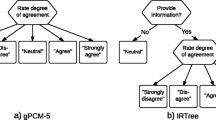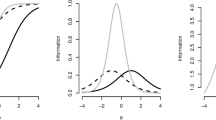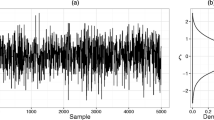Abstract
In item response theory modeling of responses and response times, it is commonly assumed that the item responses have the same characteristics across the response times. However, heterogeneity might arise in the data if subjects resort to different response processes when solving the test items. These differences may be within-subject effects, that is, a subject might use a certain process on some of the items and a different process with different item characteristics on the other items. If the probability of using one process over the other process depends on the subject’s response time, within-subject heterogeneity of the item characteristics across the response times arises. In this paper, the method of response mixture modeling is presented to account for such heterogeneity. Contrary to traditional mixture modeling where the full response vectors are classified, response mixture modeling involves classification of the individual elements in the response vector. In a simulation study, the response mixture model is shown to be viable in terms of parameter recovery. In addition, the response mixture model is applied to a real dataset to illustrate its use in investigating within-subject heterogeneity in the item characteristics across response times.





Similar content being viewed by others
Notes
\(\tilde{\pi }\) is calculated using the formula given above, \(\tilde{\uppi } =\frac{1}{\hbox {N}\times \hbox {n}}\mathop \sum \nolimits _{p=1}^N \mathop \sum \nolimits _{i=1}^n \pi _{pi} \), with \(\uppi _{\mathrm{pi}}\) calculated using Eq. 5 in which item parameters \(\upzeta _{0},\upzeta _{1},\uplambda _{i}\), and \(\upsigma _{i}\) are substituted by their posterior means, and nuisance parameters \(\tau _{p}\) are numerically integrated out using a normal distribution for \(\uptau _{p}\).
References
Bacci, S., Pandolfi, S., & Pennoni, F. (2014). A comparison of some criteria for states selection in the latent Markov model for longitudinal data. Advances in Data Analysis and Classification, 8(2), 125–145.
Bartholomew, D. J., Knott, M., & Moustaki, I. (2011). Latent variable models and factor analysis: An unified approach (Vol. 904). Hoboken: Wiley.
Birnbaum, A. (1968). Some latent trait models and their use in inferring an examinee’s ability. In E. M. Lord & M. R. Novick (Eds.), Statistical theories of mental test scores (chap) (pp. 17–20). Reading, MA: Addison Wesley.
Bock, R. D., & Aitkin, M. (1981). Marginal maximum likelihood estimation of item parameters: Application of an EM algorithm. Psychometrika, 46, 443–459.
Bolsinova, M., & Maris, G. (2016). A test for conditional independence between response time and accuracy. British Journal of Mathematical and Statistical Psychology, 69(1), 62–79.
Bolsinova, M., & Tijmstra, J. (2016). Posterior predictive checks for conditional independence between response time and accuracy. Journal of Educational and Behavioral Statistics, 41(2), 123–145.
Bolsinova, M., de Boeck, P., & Tijmstra, J. (in press). Modelling conditional dependence between response time and accuracy. Psychometrika.
Bolsinova, M., Tijmstra, J., Molenaar, D., & De Boeck, P. (2017). Conditional dependence between response time and accuracy: An overview of its possible sources and directions for distinguishing between them. Frontiers in Psychology, 8, 202.
Carpenter, P. A., Just, M. A., & Shell, P. (1990). What one intelligence test measures: A theoretical account of the processing in the Raven Progressive Matrices Test. Psychological Review, 97, 404–431.
Celeux, G., Forbes, F., Robert, C. P., & Titterington, D. M. (2006). Deviance information criteria for missing data models. Bayesian Analysis, 1(4), 651–673.
Cohen, J. (1983). The cost of dichotomization. Applied Psychological Measurement, 7, 249–253.
De Boeck, P., Chen, H., & Davison, M. (2017). Spontaneous and imposed speed of cognitive test responses. British Journal of Mathematical and Statistical Psychology, 70(2), 225–237.
De Boeck, P., & Partchev, I. (2012). IRTrees: Tree-based item response models of the GLMM family. Journal of Statistical Software, 48(1), 1–28.
DiTrapani, J., Jeon, M., De Boeck, P., & Partchev, I. (2016). Attempting to differentiate fast and slow intelligence: Using generalized item response trees to examine the role of speed on intelligence tests. Intelligence, 56, 82–92.
Dolan, C. V., Colom, R., Abad, F. J., Wicherts, J. M., Hessen, D. J., & van de Sluis, S. (2006). Multi- group covariance and mean structure modeling of the relationship between the WAIS-III common factors and sex and educational attainment in Spain. Intelligence, 34, 193–210.
Dolan, C. V., & van der Maas, H. L. (1998). Fitting multivariage normal finite mixtures subject to structural equation modeling. Psychometrika, 63(3), 227–253.
Ericsson, K. A., & Staszewski, J. J. (1989). Skilled memory and expertise: Mechanisms of exceptional performance. In D. Klahr & K. Kotovsky (Eds.), Complex information processing: The impact of Herbert A. Simon. NY: Hillsdale: Erlbaum.
Ferrando, P. J., & Lorenzo-Seva, U. (2007a). An item response theory model for incorporating response time data in binary personality items. Applied Psychological Measurement, 31, 525–543.
Ferrando, P. J., & Lorenzo-Seva, U. (2007b). A measurement model for Likert responses that incorporates response time. Multivariate Behavioral Research, 42, 675–706.
Fox, J. P., Klein Entink, R., & Linden, W. (2007). Modeling of responses and response times with the package cirt. Journal of Statistical Software, 20(7), 1–14.
Grabner, R. H., Ansari, D., Koschutnig, K., Reishofer, G., Ebner, F., & Neuper, C. (2009). To retrieve or to calculate? Left angular gyrus mediates the retrieval of arithmetic facts during problem solving. Neuropsychologia, 47(2), 604–608.
Gelman, A., & Rubin, D. B. (1992). Inference from iterative simulation using multiple sequences. Statistical Science, 7, 457–511.
Gilks, W. R., Richardson, S., & Spiegelhalter, D. J. (1996). Introducing markov chain monte carlo. In: Markov chain Monte Carlo in practice (pp. 1–19). US: Springer.
Goldhammer, F., Naumann, J., Stelter, A., Tóth, K., Rölke, H., & Klieme, E. (2014). The time on task effect in reading and problem solving is moderated by task difficulty and skill: Insights From a computer-based large-scale assessment. Journal of Educational Psychology, 106, 608–626.
Hall, D. B. (2000). Zero-inflated Poisson and binomial regression with random effects: A case study. Biometrics, 56(4), 1030–1039.
Jansen, B. R., & Van der Maas, H. L. (2001). Evidence for the phase transition from Rule I to Rule II on the balance scale task. Developmental Review, 21(4), 450–494.
Jeon, M., & De Boeck, P. (2016). A generalized item response tree model for psychological assessments. Behavior Research Methods, 48(3), 1070–1085.
Larson, G. E., & Alderton, D. L. (1990). Reaction time variability and intelligence: A “worst performance” analysis of individual differences. Intelligence, 14(3), 309–325.
Lubke, G. H., & Muthén, B. (2005). Investigating population heterogeneity with factor mixture models. Psychological Methods, 10(1), 21.
Luce, R. D. (1986). Response times. New York: Oxford University Press.
MacCallum, R. C., Zhang, S., Preacher, K. J., & Rucker, D. D. (2002). On the practice of dichotomization of quantitative variables. Psychological Methods, 7, 19–40.
McLeod, L., Lewis, C., & Thissen, D. (2003). A Bayesian method for the detection of item preknowledge in computerized adaptive testing. Applied Psychological Measurement, 27(2), 121–137.
Mellenbergh, G. J. (1994). Generalized linear item response theory. Psychological Bulletin, 115, 300–300.
Min, Y., & Agresti, A. (2005). Random effect models for repeated measures of zero-inflated count data. Statistical Modelling, 5(1), 1–19.
Molenaar, D., Oberski, D., Vermunt, J., & De Boeck, P. (2016). Hidden Markov item response theory models for responses and response times. Multivariate Behavioral Research, 51(5), 606–626.
Molenaar, D., Tuerlinckx, F., & van der Maas, H. L. J. (2015). A bivariate generalized linear item response theory modeling framework to the analysis of responses and response times. Multivariate Behavioral Research, 50(1), 56–74.
Partchev, I., & De Boeck, P. (2012). Can fast and slow intelligence be differentiated? Intelligence, 40(1), 23–32.
Plummer, M. (2003). JAGS: A program for analysis of Bayesian graphical models using Gibbs sampling. In Proceedings of the 3rd international workshop on distributed statistical computing (DSC 2003) (pp. 20–22).
Rabbitt, P. (1979). How old and young subjects monitor and control responses for accuracy and speed. British Journal of Psychology, 70, 305–311.
Ranger, J., & Ortner, T. M. (2011). Assessing personality traits through response latencies using item response theory. Educational and Psychological Measurement, 71(2), 389–406.
Rummel, R. J. (1970). Applied factor analysis. Evanston: Northwestern University Press.
Schnipke, D. L., & Scrams, D. J. (1997). Modeling item response times with a two-state mixture model: A new method of measuring speededness. Journal of Educational Measurement, 34, 213–232.
Shiffrin, R. M., & Schneider, W. (1977). Controlled and automatic human information processing: II. Perceptual learning, automatic attending and a general theory. Psychological Review, 84, 127.
Spiegelhalter, D. J., Thomas, A., Best, N. G., & Gilks, W. R. (1995). BUGS: Bayesian inference using Gibbs sampling, Version 0.50. Cambridge: MRC Biostatistics Unit.
Spiegelhalter, D. J., Best, N. G.-, Carlin, B. P., & van der Linde, A. (2002). Bayesian measures of model complexity and fit (with discussion). Journal of the Royal Statistical Society Series B, 64, 583–640.
Stan Development Team. (2015). Stan modeling language users guide and reference manual. Version 2(9)
Siegler, R. S. (1976). Three aspects of cognitive development. Cognitive Psychology, 8, 481–520.
Thissen, D. (1983). Timed testing: An approach using item response testing. In D. J. Weiss (Ed.), New horizons in testing: Latent trait theory and computerized adaptive testing (pp. 179–203). New York: Academic Press.
Thomas, A., Hara, B. O., Ligges, U., & Sturtz, S. (2006). Making BUGS open. R News, 6, 12–17.
Titterington, D. M., Smith, A. F. M., & Makov, U. E. (1985). Statistical analysis of finite mixture distributions. Chicester: Wiley.
Tuerlinckx, F., & De Boeck, P. (2005). Two interpretations of the discrimination parameter. Psychometrika, 70(4), 629–650.
Van Harreveld, F., Wagenmakers, E. J., & Van Der Maas, H. L. (2007). The effects of time pressure on chess skill: An investigation into fast and slow processes underlying expert performance. Psychological Research, 71, 591–597.
Van der Linden, W. J. (2007). A hierarchical framework for modeling speed and accuracy on test items. Psychometrika, 72, 287–308.
Van der Linden, W. J. (2009). Conceptual issues in response-time modeling. Journal of Educational Measurement, 46(3), 247–272.
Van der Linden, W. J., Breithaupt, K., Chuah, S. C., & Zhang, Y. (2007). Detecting differential speededness in multistage testing. Journal of Educational Measurement, 44(2), 117–130.
Van der Linden, W. J., & Glas, C. A. (2010). Statistical tests of conditional independence between responses and/or response times on test items. Psychometrika, 75, 120–139.
Van der Linden, W. J., & Guo, F. (2008). Bayesian procedures for identifying aberrant response-time patterns in adaptive testing. Psychometrika, 73(3), 365–384.
Van der Linden, W. J., Klein Entink, R. H., & Fox, J. P. (2010). IRT parameter estimation with response times as collateral information. Applied Psychological Measurement, 34(5), 327–347.
van der Linden, W. J., & van Krimpen-Stoop, E. M. (2003). Using response times to detect aberrant responses in computerized adaptive testing. Psychometrika, 68(2), 251–265.
van der Maas, H. L., Molenaar, D., Maris, G., Kievit, R. A., & Borsboom, D. (2011). Cognitive psychology meets psychometric theory: On the relation between process models for decision making and latent variable models for individual differences. Psychological review, 118(2), 339–356.
Wang, C., & Xu, G. (2015). A mixture hierarchical model for response times and response accuracy. British Journal of Mathematical and Statistical Psychology, 68, 456–477.
Wang, C., Xu, G., & Shang, Z. (2016). A two-stage approach to differentiating normal and aberrant behavior in computer based testing. Psychometrika. https://doi.org/10.1007/s11336-016-9525-x.
Watanabe, S. (2010). Asymptotic equivalence of Bayes cross validation and widely applicable Information criterion in singular learning theory. Journal of Machine Learning Research, 11, 3571–3594.
Yung, Y. F. (1997). Finite mixtures in confirmatory factor-analysis models. Psychometrika, 62(3), 297–330.
Author information
Authors and Affiliations
Corresponding author
Additional information
The research by Dylan Molenaar was made possible by a grant from the Netherlands Organization for Scientific Research (NWO VENI- 451-15-008). We are grateful to three anonymous reviewers whose comments led to substantial improvements of this paper.
Electronic supplementary material
Below is the link to the electronic supplementary material.
Appendix: OpenBUS Syntax to Fit the Full Response Mixture Model
Appendix: OpenBUS Syntax to Fit the Full Response Mixture Model

Rights and permissions
About this article
Cite this article
Molenaar, D., de Boeck, P. Response Mixture Modeling: Accounting for Heterogeneity in Item Characteristics across Response Times. Psychometrika 83, 279–297 (2018). https://doi.org/10.1007/s11336-017-9602-9
Received:
Published:
Issue Date:
DOI: https://doi.org/10.1007/s11336-017-9602-9




